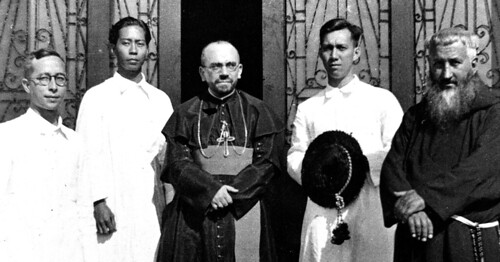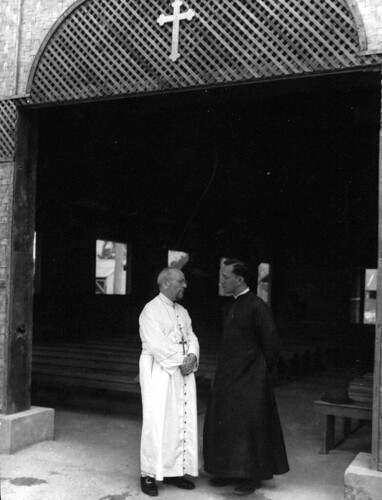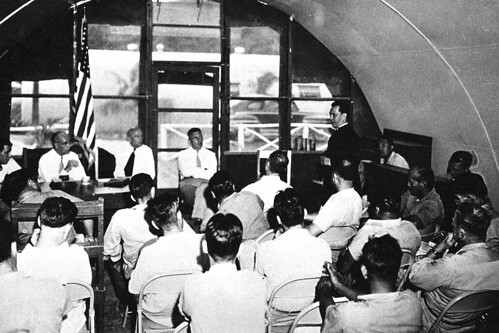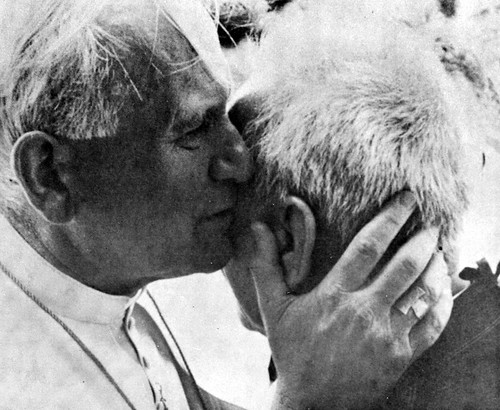Monsignor Oscar Calvo
CHamoru patriot priest
On 10 January 1942, all foreign Catholic missionaries in Guam were sent by the Japanese occupying forces to prisoner of war camps in Japan. This left the spiritual guidance of the entire Catholic congregation on island in the hands of its only two CHamoru priests, Fathers Jesus Baza Duenas and Oscar Lujan Calvo. Reverend Joaquin Flores Sablan tended to the Protestant congregation of Guam.
They did their best to serve the CHamoru people under the trying conditions set forth by the Japanese authorities. Calvo and Sablan were able to survive the war; Duenas was beheaded by the Japanese.
After the war, Calvo worked day and night for the re-establishment of the Catholic Church in Guam. Even in his later years, when poor eyesight restricted his activities, Fr. Calvo did all he could to promote the CHamoru culture and the reconciliation of the Japanese people with his native islanders. He was the quintessential CHamoru patriot priest.
Early years
Oscar Lujan Calvo (1915 – 2000) was born in Hagåtña, the son of Ramon Perez Calvo and Isabel Pangelinan Lujan Calvo. He was a member of one of Guam’s most prominent families, the Calvos. His Lujan relatives were also known as devout Catholics and close friends of the Spanish Capuchin missionaries. Calvo was the oldest of 13 siblings.
In 1928, at the age of 13, Calvo departed Guam for Manila to enter the San Jose Seminary, which was run by the Jesuits, as a diocesan seminarian for the Guam Vicariate. Finishing his studies in 1941, he was ordained a priest on 5 April 1941 at the hands of Bishop Miguel Angel Olano, OFM Cap., becoming the third CHamoru priest in history and the second ordained in the Agaña Cathedral. From then on, he was to be known as “Pale’ Skåt,” (Father Skåt) after the CHamoru pronunciation of the name “Oscar.”
As a young priest, Calvo was assigned the responsibility of the San Antonio Chapel, in a barrio of pre-war Hagåtña after which the chapel was named.
Struggle of World War II
The Japanese occupation of Guam, which began on 10 December 1941, thrust the young priest into the midst of a volatile and precarious situation. As a native priest, he was allowed to remain in Guam with Fr. Duenas, his senior in the priesthood by two years, named Pro-Vicar (temporary church head) in the absence of Bishop Olano. Calvo was kept very busy in the first days of the occupation, moving church property from the Agaña Cathedral, confiscated for use by the Japanese, to his own San Antonio Chapel and other temporary havens among private homes. He also gave many CHamoru victims of the Japanese invasion a proper burial since many of them had been haphazardly buried in shallow graves. He also tried to tend to the needs of the interned bishop and missionaries.
When all the foreign missionaries departed, he and Duenas divided the work that lay before them to care for some 22,000 CHamoru Catholics. As provisional church head, Duenas, who was already pastor of Inalåhan, decided to care for the south and gave Calvo responsibility for everything north of Chalan Pago and east of Piti. Calvo based himself at his father’s ranch in Maite, visiting many outlying chapels regularly in the northern and central regions of Guam. One such chapel in Tutujan (which is now Agaña Heights) secretly housed the Blessed Sacrament.
Calvo knew that he had to be as available as possible for the spiritual good of the people. In order to accomplish that, he had to remain in the good graces of the occupying forces as much as his conscience would allow. Sometime in May of 1942, Commander Hiroshi Hayashi, in charge of the civilian administration of occupied Guam, asked Calvo to translate into CHamoru a memorial to those who died in the Japanese invasion of Guam on 10 December 1941. The inscription was placed on an ifil wood monument. Hayashi also asked Calvo to celebrate the Catholic requiem rites for all those who died during the invasion of Guam. Calvo complied with the request and the ritual was performed at a location near the present-day Navy cemetery in Hagåtña. From that time on, Calvo got on well with Hayashi, who was pleased with Calvo’s cooperation.
Because of his good rapport with the Japanese administration, Calvo was able to pursue his spiritual work unhampered, although he was always wary of the dangers that were ever-present. The war sometimes placed Calvo in a difficult position; on a few occasions, people in trouble with the Japanese went to Calvo for assistance. Among these was the the last American in Guam, Navy radioman George Tweed, who was being hidden by the CHamorus from the Japanese.
During the Japanese occupation, Calvo also got to know two Japanese priests, Father Petro Komatsu and Monsignor Dominic Fukahori, who was at the time Apostolic Administrator of Fukuoka, Japan. Both priests were sent to Guam by the Japanese authorities. Fukahori and Calvo were to establish a friendship that would eventually lead them to a common project to create a peace memorial many years later.
After the war: A man with many tasks
The beheading of Duenas by the Japanese on 12 July 1944 left Calvo as the sole Catholic priest on island and, although not officially named, the island’s de facto ecclesiastical head for the time being. From August 1944 until the arrival of two American Capuchin missionaries, Fathers Anselm Leahy and Paul Toschik, on 28 June 1945, Calvo was assisted only by American military chaplains, who did much for the CHamoru Catholics by helping build temporary chapels and by celebrating the sacraments. Bishop Olano returned to Guam on March 21, 1945 and was housed by the Calvo family while Calvo built a house for him. The house was completed only in time for the Olano’s successor (Bishop Baumgartner). Calvo’s family continued to shelter Olano and Baumgartner when he arrived and to feed the first Capuchin missionaries after the war.
While living with his family in Sinajana, Calvo tended to many tasks, especially the building of a temporary cathedral in Hagåtña made of cariso, a swamp bamboo. Calvo was the first post-war rector of the cathedral. A church named in honor of St. Jude and made of cariso was also constructed in Sinajana under Calvo’s supervision. Calvo also went all over the island looking for land to be purchased or received as a donation for the new churches that would have to be built.
One of Calvo’s urgent desires was the proper burial of the body of his fellow priest, Fr. Duenas. With the help of an interpreter from Saipan who knew the whereabouts of the site, Calvo and the military authorities were able to exhume the body of Fr. Duenas on 21 March 1945, and have it buried in the sanctuary of St. Joseph Church, Inalåhan, where Duenas had been pastor before and during the war.
When American Bishop Apollinaris Baumgartner, OFM Cap. took over the Guam Vicariate in October of 1945, Calvo became his right hand and also his interpreter. Baumgartner and most of the post-war American missionaries did not learn to speak CHamoru; the pre-war missionaries who did return to Guam after the war did speak CHamoru. Calvo was also frequently called on by the military government to act as a liaison between it and the CHamoru population.
Controversy with Tweed
In 1945, Navy radioman first class George Tweed wrote a book, Robinson Crusoe, USN, recounting his life in Guam hiding from the Japanese during the war. In the book, Tweed made two accusations against both Frs. Duenas and Calvo. Concerning Fr. Duenas, Tweed accused the late priest of violating the seal of confession by revealing information allegedly learned in confession about the whereabouts of Tweed. With respect to Calvo, Tweed alleged that Calvo had revealed to another something Tweed and Calvo discussed in confidence. These allegations created a stir among many CHamorus, since Fr. Duenas was no longer alive to defend himself and since both accusations were formally denied by sworn affidavits from the very sources Tweed relied upon.
In September of 1946, Tweed returned to Guam for a visit. At a ceremony at the Plaza de Espana where Tweed was to be introduced, a crowd of about 100 protesters, lead by Calvo, marched into the Plaza holding placards in protest of Tweed’s presence. News of the demonstration was carried by the national press.
Agana Heights pastor
In 1949, Calvo was re-assigned as pastor of Our Lady of the Blessed Sacrament Church in Agana Heights. The plans for a new, permanent church had laid dormant for a few years due to the poor financial situation of the contractor, but Calvo revived the project with new vigor. The new church, in existence today, was dedicated on 4 March 1951. Calvo remained pastor of Agana Heights until 1959. In 1952, Calvo was instrumental in bringing back to Guam for burial the remains of Fr. Jose Ada Manibusan, the fourth CHamoru ordained a priest who had died in the Philippines during World War II.
Founder of many post-war organizations
Calvo organized, with Bishop Baumgartner, the Holy Name Society for Catholic men and was its first spiritual director. Later, he helped organize the Arch-confraternity of Christian Mothers. He was one of the first members of the Catholic Board of Education and helped in the founding of the Ta’i Mercy Convent. In 1946, he helped incorporate the Guam Council of the Boy Scouts of America. From 1945 until 1960, he was a member of the Board of Directors of the Guam Memorial Hospital. He also taught the CHamoru language at the Territorial College of Guam, predecessor of today’s University of Guam. In 1953, he helped form a charitable association, the Helping Hands of Guam, which assisted the needy at a time when government-funded assistance was limited.
Calvo was eventually sent to the south of Guam in 1946, using the old Malesso’/Merizo Konbento, or priest’s residence, as his headquarters while attending to Malesso’, Humåtak, Inalåhan and Talo’fo’fo. In Inalåhan, Calvo started the Coconut Festival, which sought to preserve the traditional CHamoru link with agriculture. Before long, American Capuchin missionaries were able to resume work in Malesso’ and Humåtak with Calvo remaining in Inalåhan.
In 1947, in recognition of his heroic services to the church during and after the war, Pope Pius XII, at the request of Bishop Baumgartner, elevated Calvo to the rank of Monsignor by awarding him the title of Honorary Papal Chamberlain.
An active retirement
In 1959, Calvo suffered a heart attack. He asked Bishop Baumgartner to be relieved of parish work. His eyesight, which was eventually to deteriorate to near total blindness in later years, was beginning to become a problem as well. Given permission to retire, Calvo took up residence with his siblings in Agaña Heights.
Although impeded by his poor vision, Calvo lead an active life from his family home. At his family residence, he received many visitors and participated in many civic and cultural projects. He was made Chaplain at the Guam Memorial Hospital in 1962. He was a member of the CHamoru Language Commission. He had re-printed a book of Bible stories in CHamoru and a pictorial book of Guam’s history from 1521-1940. He also took the statue of Our Lady of Camarin and had it repainted and touched on in the Philippines. Besides these activities, two other projects deserve special mention.
Yigo Peace Memorial
For some time, Japanese groups would come to Guam frequently to pay respects to their war dead whose remains were scattered in unmarked locations throughout the island. Calvo was most helpful in assisting these groups. In 1965, Calvo started the South Pacific Memorial Association, membered by both local and Japanese participants, whose goal was the building of a peace memorial. The memorial would be a means of reconciliation between the CHamoru people and the Japanese who occupied the island in World War II. The site chosen for this memorial was Mataguac, Yigo, scene of the last organized battle between the Japanese and the United States forces in 1944. One of Calvo’s Japanese counterparts in this project was Dominic Fukahori, then the Bishop of Fukuoka, Japan. The entire expense for this project was financed by Japanese funding sources. Calvo spent some time in Japan soliciting funds and gaining support for the project from Japanese civic groups. He also secured the support of the US Department of State for the project.
In 1970, the Peace Memorial was dedicated. Among its several buildings which have grown incrementally over the years, most prominent is a tall structure built in the form of praying hands. Buddhist and Christian prayer services have been held at the Peace Memorial on certain occasions ever since. The frequent contact between Calvo and Japanese supporters of the Peace Memorial project did its part in opening up Guam to Japan as a travel destination.
San Vitores beatification
Msgr. Calvo was also most eager to promote the beatification of the Jesuit Diego Luis de San Vitores, the founder of the Catholic Church in Guam who has been revered by many as a martyr. Calvo had an English translation of Risco’s Italian book on San Vitores (The Apostle of the Marianas) published and distributed in Guam to increase interest in the cause. Calvo also traveled to Spain in search of archival material on San Vitores to bring to Guam.
A 1683 original copy of a more authoritative biography of San Vitores, The Life and Martyrdom of Diego Luis de San Vitores, SJ, by Francisco Garcia, came into the hands of Calvo by way of Francisco Muna de la Cruz, who had found it in Manila. Calvo turned this copy over to the diocese and it was eventually translated into English. San Vitores was beatified in Rome by Pope John Paul II in 1985.
Honors and tributes
Before his death, many honors were showered on Calvo, both by the church and the government. On the occasion of his 40th anniversary of priesthood, in 1981, Congressman Antonio B. Won Pat flew an American flag at the US Capitol in Washington, DC, in his honor. In 1986, Emperor Hirohito of Japan awarded Calvo the Order of the Rising Sun, Gold and Silver Rays, a rare imperial honor bestowed on a non-Japanese civilian. On 8 December 1999, the Dulce Nombre de Maria Cathedral-Basilica in Hagåtña named its historical gallery in honor of Calvo. On that same day, Congressman Robert Underwood flew at the US Capitol the same flag flown by Won Pat in 1981.
Calvo has also been honored by his alma mater, San Jose Seminary, with an award for his service in the Cause of Christ’s Priesthood. In August of 2000, Calvo was posthumously recognized by the First Lady of Guam as one of the ten pioneers of the Organic Act of Guam.
But perhaps the greatest honor in Calvo’s eyes was his meeting Pope John Paul II in Guam in 1981. Calvo decided to forgo meeting the Pope at any other venue and to meet him instead with the sick who were gathered at Guam Memorial Hospital. When the Pope walked through the gathering, he moved towards Calvo and gave him a paternal kiss.
Calvo was a member of many groups and associations, among them, chaplain and historian for the Young Men’s League of Guam, a charter member of the Rotary Club of Guam, a charter member of the Knights of Columbus (fourth degree), a tertiary of the Secular Franciscan Order, and a member of the Sovereign Order of Malta.
On 28 July 2000, Calvo died at Guam Memorial Hospital, just five days shy of his 85th birthday.
For further reading
Guam War Survivors. “Home.” Last modified 27 June 2021.
Olano y Urtega, Miguel Angel, OFM Cap. Diary of a Bishop: Since the Invasion of Guam – World War II. Manila: University of Santo Tomas Press, 1949.
Rogers, Robert. Destiny’s Landfall: A History of Guam. Honolulu: University of Hawai`i Press, 1995.
Sinajaña, Eric de, OFM Cap. Historia de la Misión de Guam de los Capuchinos Españoles. Pamplona: Curia Provincial de los Capuchinos, 2001.
Sullivan, Julius, OFM Cap. The Phoenix Rises: A Mission History of Guam. New York: Seraphic Mass Association, 1957.








